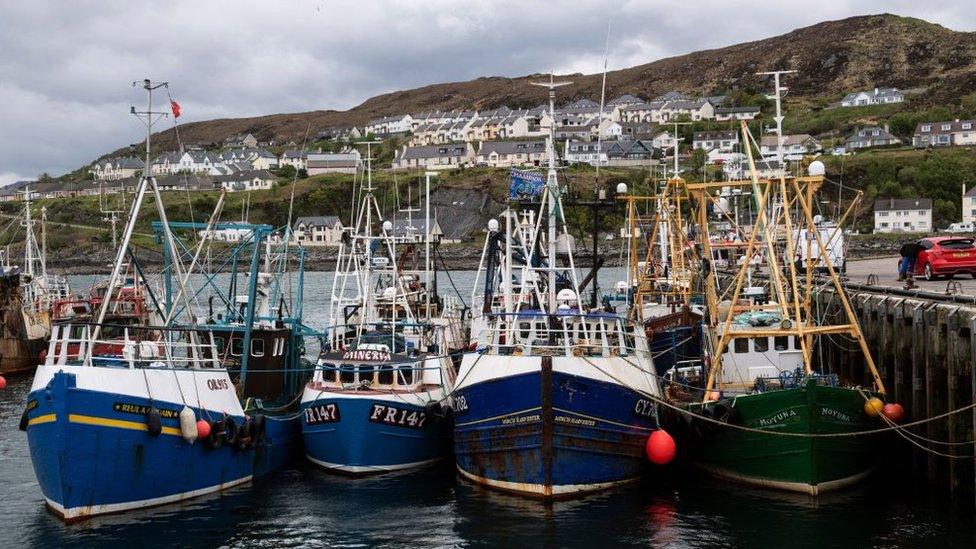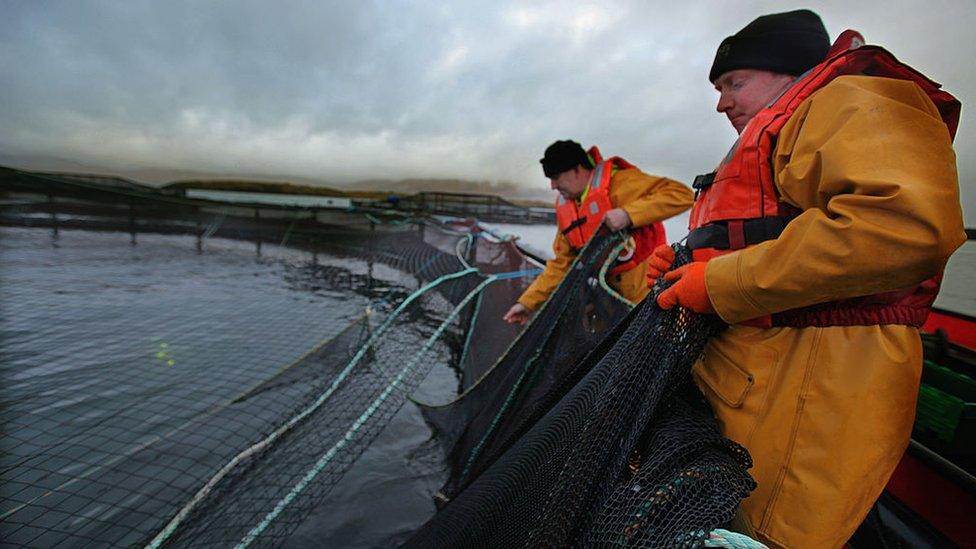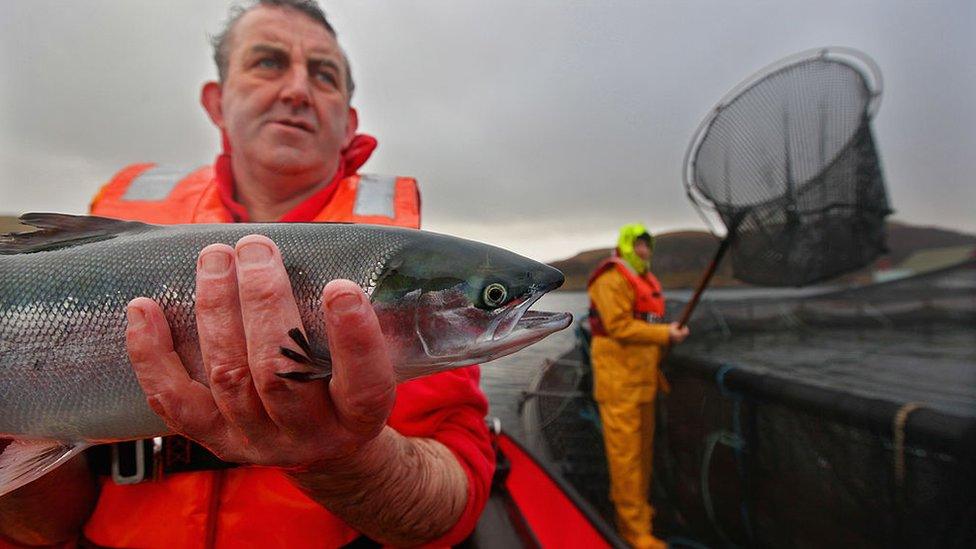Fish face a sea-change
- Published

Covid's Omicron variant has meant another delay to two decades of effort to reduce over-fishing
Swimming against the upstream currents of Brexit and Covid, fish farming is proving resilient, and new figures show where in Scotland the most salmon are being produced
Fifty years after it began, the next stage in the industry's growth depends on a review of licensing conditions, due next year. There's a signal from one producer that the future may mean less time for salmon spent at sea and more of their growth in land-based tanks.
Among the first victims of the omicron variant of Covid were the world's fish, and in particular, the 34% of fish stocks being overfished at a level where they can't replenish.
There has been a 20-year wait since it was agreed that action had to be taken to cut back on over-fishing, through agreement at the World Trade Organisation (WTO).
Twenty years on, and this was to be the week in Geneva where they got to grips with colossal subsidies towards national fishing fleets.
The estimates vary widely, from $14bn up to $54bn (11bn-£41bn), in support through low or little fuel tax, and other mechanisms that retain too much fishing capacity.
It's not just in Peterhead, Shetland and Cornwall that fishing is politically sensitive. It touches an electoral nerve everywhere coastal towns have built up for many centuries around the industry.
So the negotiations have been particularly laborious. A draft part-agreement was finalised last week, for ministers to take on at this week's WTO meeting in Geneva. But it contains bracketed sections where the sides still could not agree without political sign-off, including the rules for policing such a deal.
Then came omicron. The meeting's off, and the WTO has decided that the issues are too difficult to resolve by more virtual meetings.
So the over-fishing goes on, it becomes more expensive to catch the falling stocks of fish, and coastal communities face declining income.
The United Nations reckons that 39 million people depend directly on fish capture around the world, and fish provides around 20% of the protein, on average, for 3.3 billion people.
Brexit and Covid
I mention this as a bit of marine context for the latest from Scotland's fish farmers. Aquaculture is one of the answers to over-fishing. There's more tonnage from it worldwide than wild fish capture. But it too has to be done in a sustainable way.
Salmon Scotland, which changed its name at the start of November from the Scottish Salmon Producers Organisation, has some new figures that suggest it is not doing at all badly at handling the twin challenges of Covid and Brexit.

It's impossible to disentangle the effect of these twin hits to the industry. Scottish premium prices dropped because salmon trucks were taking longer to get to market in Boulogne and beyond. But prices also dropped because restaurants were closed by lockdown.
And yet a swift shift into more retail and home cooking of salmon have seen prices hold up pretty well in the circumstances. Exports on long-haul flights have also been curtailed, and more sent into France, as the biggest single export market.
"Sales of fresh and chilled Atlantic salmon to the EU have now reached record volumes, helping it to maintain its position as the UK's most valuable food export", according to Tavish Scott, chief executive of the trade body.
Almost £192m worth of salmon was exported from Scotland in the third quarter of 2021, down slightly on the second quarter, but with nine months of exports in 2021 ahead of the whole of 2020.
The expectation is for 217,000 tonnes of production this year - an increase of 4.5% on last year, and a sign that the deep-seated 'biological' problems the industry has faced may be receding a bit. For 'biological', read sea lice and disease.
Robust growth
For the first time, Salmon Scotland has put some regional meat on its statistical bones, with a breakdown showing shares of 60,600 tonnes of production in July to September.
None of it is in the east coast, because that's banned. The north coast and west Highlands produced 26% of the total, Argyll and the Clyde had 23%, followed by Shetland with 20%, the Outer Hebrides with 19% and Orkney on 11%.
The industry awaits news on what it's allowed to do next, because - 50 years since salmon farming was first pioneered near Fort William - a review of licensing for salmon farming is under way.
That is being led by Professor Russel Grigg, government's go-to business consultant on a wide range of challenges, from bank branch closures and small business lending to the setting up of South of Scotland Enterprise.

His conclusions are expected early in 2022. The industry hopes they'll speed up the process of licensing, if only to get to rejection.
As things stand, changes to licence conditions require at least four public agencies to give their advice. And while consultation is generally a good thing, it is absurd that each one of them has to consult with each other.
Beyond the bureaucracy, Scottish salmon production is constrained by a maximum size to the biomass (the aggregate weight of fish) at any given site, of 2500 tonnes. Because salmon grow rapidly, that requires careful management, with critics complaining that the condition is breached too often.
There is the possibility of gaining permission for higher tonnage, but on condition that the sites are moved into more open water, where they can do less damage to coastal wildlife.
That is becoming more possible, as cages are designed to withstand heavier seas. However, the practical barriers to getting those changed licence conditions mean that little has changed, and everyone awaits Professor Griggs.
He'll be aware that there could be a sea-change in the methods of salmon farming, led by the new owners of Scottish Salmon Company, based in the Faroes.
Bakkafrost is putting a lot of kroner into growing Scottish salmon to a later stage in its life in land-based tanks, so that they spend less time in the sea cages, when they are more robust in the face of those biological challenges.
Wholly land-based salmon farming was being seen earlier this year as an exciting new prospect for the industry worldwide, though the gloss has lately come off that investment boom.
Instead, the direction of travel is more likely to be consolidation into fewer, bigger offshore sites, and fish spending less time at sea.
